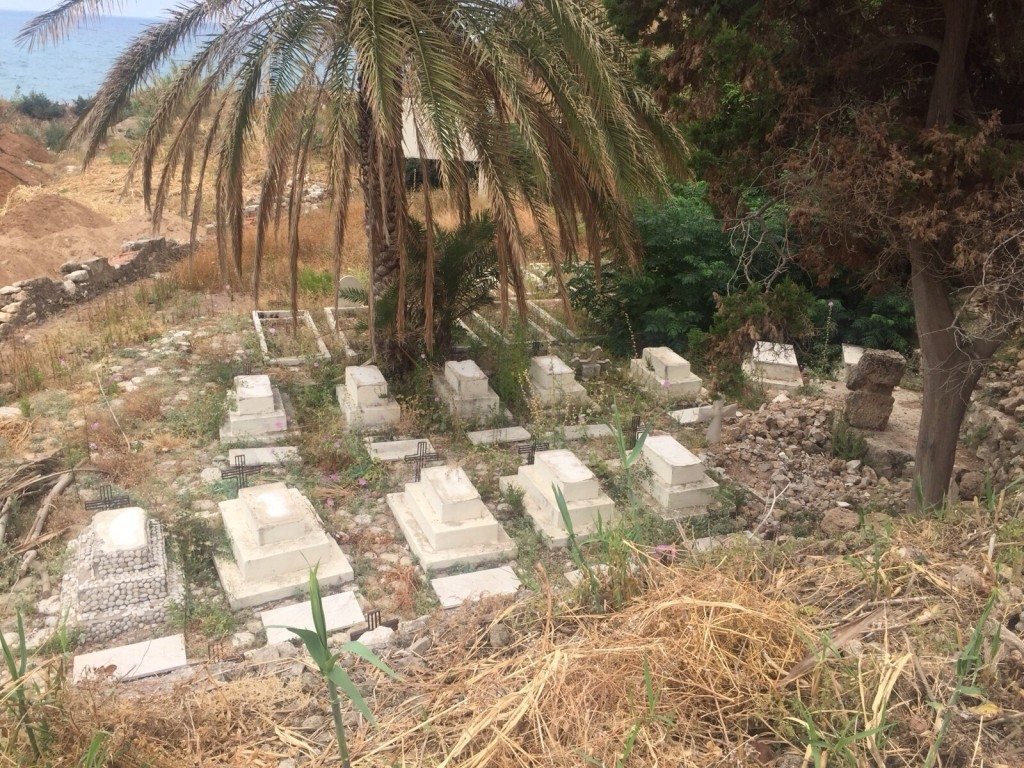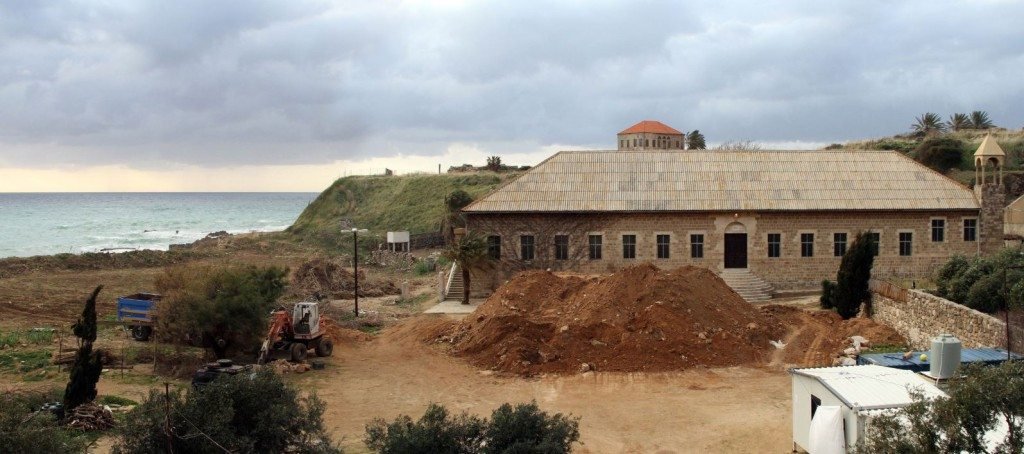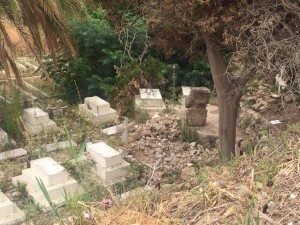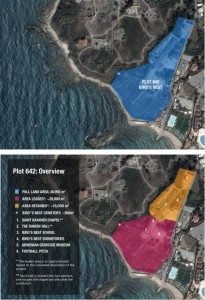BEIRUT, Lebanon (A.W.)—Over the past few months, reports have appeared in various media outlets claiming that a a luxury beach resort will be built on two-thirds of the historic Bird’s Nest Orphanage plot in Jbeil, Lebanon (see map for exact areas). In early February, the Board of Directors of Bird’s Nest (Trchnots Pooyn, in Armenian) informed the community—particularly the relatives of those who are buried in the cemetery—that plans for the site now envision relocating the 33 individual graves to 2 collective tombs on the upper part of the plot. Around two-thirds of the graves are of orphans; one-third are of genocide survivors or employees of the orphanage born before 1915. The decision to relocate the bodies was purportedly made to “bring the remains of these orphans closer to the grave of Maria Jacobsen, the founder of the orphanage.” They will rest next to a new museum dedicated to the orphans and to the orphanage. The museum is slated to officially open on July 18.

The church released a statement in late February that reads, “Taking into account the financial difficulties that the Bird’s Nest has been facing, and the abandoned state of the seaside area of the plot, it was found appropriate to lease the mentioned land to be used by families for social and sporting purposes. The tenant is former Minister and Mayor [of Jbeil] Jean Louis Kordahi. A memorandum of understanding has been signed between the tenant and the Catholicosate of the Greater House of Cilicia detailing the duration, and purpose of use of the land.”
Vartan Avakian, the great-grandson of Hagop Avakian, who was born in 1894 in Fendijak, Cilicia (Ottoman Empire), and who was among the earliest genocide survivors to settle in Lebanon and to later be buried in this cemetery, researched the church’s plan and began lobbying against the project. When all attempts failed, opponents of the project created a website and an online petition to raise awareness among the public, and to explain the reasons behind their objection.
Last week in an interview with Cilicia TV, Seta Khedeshian, the executive director of Bird’s Nest, labeled the outspoken critics of the project as “irresponsible,” and accused them of spreading “false information.” She said the plan to move the graves was made prior to the new plans, and that by relocating the graves it was the committee’s goal to offer visitors a testimony of the lives of the orphans of the genocide and the that care “Mama” Jacobsen provided the children. Khedeshian, however, did not address some of the main concerns of the opponents of the plan that were raised in the petition, which has garnered more than 800 signatures.
Concerns over the Project
Bird’s Nest is historically symbolic for the Armenians of Byblos, Lebanon, and the to the diaspora in general. It is a testimony of the will of the Armenian people to survive, live, and create despite the genocide. For many members of the community in Byblos, it also represents the center around which the Armenian neighborhood was later formed.
Opponents of the plan argue that the beachfront project would not only harm the character of the site and disrupt the residents’ sense of belonging, but would also affect two important landmarks situated on the plot: the cemetery and Nicol Hall, which houses the St. Kayane Chapel.
Exhuming the Bodies of Genocide Survivors
The Bird’s Nest Cemetery is viewed by many as a memorial to Lebanon’s historical role as a refuge for victims of humanitarian catastrophes. Each of the 33 graves of the Armenian Genocide survivors is a testimony to and legacy of their journey and survival. Removing their bodies from what should have been their final resting place and into a “mass grave” is a tragic disruption, argue opponents of the plan. “The symbolism behind moving people who have survived the genocide … from their individual tombs to a collective mass grave, seems to have escaped the decision makers,” says Vartan Avakian. “A collective mass grave is a symbol of genocide rather than survival.”
In the interview with Cilicia TV, Khedeshian claimed that the cemetery has long been neglected, and that some of the graves no longer bear the names of the deceased, nor are they visited by their families. A nearby resident, however, related that families visit the cemetery at least twice a year on Merelots, that the site is seen as a place of pilgrimage, and that it is often visited during genocide commemoration events, even if it is poorly maintained by the institution in charge.
As the map shows, the surface area of the cemetery, which located on the east side, is 250 square meters (roughly 2,691 square feet, or 1 percent of the area of the plot), and is classified as public domain under the zoning regulation for the preservation of the historical site of Byblos.* Furthermore, the municipality of Byblos has plans to construct a pedestrian walkway bridging the old port of Byblos to Armenia Street. This new walkway would give the cemetery of the genocide survivors its due value by improving its visibility and accessibility. Importantly, the cemetery also lies in the buffer zone of a UNESCO World Heritage Site, a unique spot for a genocide memorial.
On June 29, without any legal documentation, workers began digging at the site. They were stopped by members of the Avakian family, who had obtained a court order to temporarily halt the construction activities in the cemetery.
The online petition urges the Catholicosate to put an end to the destruction of the cemetery for ethical and historical reasons, taking into consideration that it comprises only 1 percent of the 20,000 square meters (or about 215,278 square feet) of the land being leased.
“[Mass graves] occur when unidentified or ownerless human remains or bodies are found as a result of mass murders or massacres,” wrote architect Diran Harmandayan on the petition page. The graves at the Bird’s Nest “are not ownerless or unidentified. They belong in the first place to the Armenian community in Lebanon and to the Lebanese at large, as a heritage, and constitute authentic witnesses of the calvary of the Armenians who found refuge in Lebanon.”
Nicol Hall – St. Kayane Chapel
Since the zoning and building laws in Lebanon do not allow for any more permanent structures to be erected on this plot, the plan will appropriate the 1921 Nicol Hall, which was built by the orphans, and either demolish it or use it as the main building for the resort. It will also house a restaurant and a boutique hotel, according to the architectural plans reviewed by some of its critics.

Khedeshian claimed that Nicol Hall has long been a dining hall that only recently was being used as a church. However, some Byblos residents say that the hall has two sections: The Danish hall, which was used as an auditorium by the orphans and later by the residents, and the St. Kayane Chapel, which has served as the only place of worship for Armenians in Byblos since prior to the 1950’s. In fact, the structure is recognized as a church in the Real Estate Certificate and Cadastral Survey of 1949.
The questions that have been raised seem to be: How ethical is it for a religious institution to lease land of such historical and cultural value for a luxury beach resort? And should the fate of a building that dates back to the early 1900’s, that was used as a church and as a school facility by those saved from the genocide, be turned into a resort or a restaurant?
The petition calls for the preservation of the St. Kayane Chapel because the current plan, if carried out, will erase an important part of Armenian history, memory, and patrimony in Byblos.
Issues of Transparency
The interview with Khedeshian, although it aimed to clarify the so-called “fallacies” that have been circulating in the media, did not clarify important details about the project.

No clear report has yet been given regarding the type and scope of the project, although Khedeshian stated that the Bird’s Nest Committee had issued announcements detailing each and every plan the institution foresees for the site.
The committee did not circulate a map of the leased area or clarify the number of years it will be leased, the type of deal made between the institution and the investor, and how the institution stands to profit from the project.
When asked about what it will gain from this “profitable project,” Khedeshian simply said that a new church, worth $1 million, will be built on the upper part of the plot, and a few structures will be renovated.
Opponents to this development say that such a project should be openly discussed in a town hall-style meeting with the presence of community members, as well as professionals in the fields of architecture, heritage, urban planning, and archeology. And that it is the right of every Armenian and Lebanese at large to question the proposed project, especially as it includes plans that so significantly affect the cemetery.
Real profits vs. Real Losses

The fact that the institution would like to use its empty land to cover its expenses may seem reasonable to many, including some of the opponents of the beach resort project. Khedeshian argued that the cost of maintaining the property has increased, and that the financial flow from external sources has dried up. If the plan succeeds, she said, the developer would offer $1 million to construct a new church on site. She insisted that no structures would be demolished.
Yet, there needs to be a proper understanding of the history of the site, proper respect shown to its many components, an appreciation and preservation of the value each carries, and consideration of its meaning to the people, insist opponents of the plan.
One recurring question that they are asking is: What would the institution lose if the cemetery were to remain in place, at the edge of the plot, and an investment that respects the historical and national heritage of Bird’s Nest is designed for the rest of the land?
Although the Bird’s Nest Committee has repeatedly stated that the relocation of the graves is within the scope of another project—that of bringing them closer to the resting place of Maria Jacobsen—opponents fear that it is largely motivated by the desire to make way for the new seafront development, as a resort adjacent to a cemetery might not be too appealing for vacationers.
“The 33 graves are history’s witnesses in the face of humanity that will convey their powerful message only if kept in their natural state. They should not be subject to any change,” said architect and urbanist Arpi Mangassarian, adding that with a little landscaping, the site could become an important destination for visitors of Byblos and Lebanon.
* The Directorate General of Antiquities refused an early plan to develop the section of the plot adjacent to the archeological site and has identified it as an archeological buffer zone. The 4,000 square meters where the cemetery is situated is in the buffer zone of a World Heritage Site.



I heard a lot of good stories about Bird’s Nest orphanage from my mom where she grew up with her two sisters after losing their parents in 1947 and calling Maria Jacobson as their Mama.
At this point I am not sure what are the positions of the catholicosate and other Armenian institutions on this issue. During the early reactions, Armenian papers gave way to Ms. Khedeshian’s explanatory and accusatory interview, giving the impression that the project opponents are “at fault”. Now, especially after Armenian’s article it seems, the tide has changed and we are “hearing” about the opponents of the project. Although I find that we should do our utmost to respect the memory of our ancestors, I find it odd at this day and age that our objections do not include equally arguments for the conservation of the environment and the world heritage. I think they all should go hand in hand.
As the daughter of someone raised in the Birds Nest I find it very sad to hear about these attempts to change/dismantel this special place. At the same time I do understand the pressures of modern life: profits, ambitious developers, etc.
This is a very difficult situation for all concerned.
But at the very least the Birds Nest needs to be more transparent about their plans and more open to consultation with community members.
Since the advent of the computer I’ve become more aware of the forced migration of my Armenian Family & would like to know if there R any Boya(d)jians,Demorjians or Dilberians intered there . Please do not desecrate any more of our Armenian Heritage for money , since this was one of the underlying motivations of R Genocide in Turkey !
I don’t know what to think. I’d like to hear from people who know the area.
I am one of the student of Birds Nest from end of 1969 to 1974 I am one of the care taker student in the school that we kept the school clean & build around, now to see what the school looks like it make me very upset & angry, I been in US more then 35 years & I donate all the time to my church as A Armenian now to see my Armenian church doing this kind of project to gain more money which it is not in off the donations coming to the church, well I think if they cut there expanse they don’t need to leas the school property .
Matios.
This reminds me of the Melkonian Educational Institute scandal a decade ago. First, the directors vehemently denied the closure only to later unanimously vote in favor of the closure on March 14, 2004. The school was shuttered for good in June of 2005.
This prime seaside real estate will eventually be force to be sold off by the powers that be. Let us not forget that Lebanon is in the Orient. Countries in the third world, including Armenia, do not have the mechanism to protect minorities as do the democracies of the West. The majority will eventually squeeze the minorities out. For instance, most Armenians in the third world have either been, or are in the process, of being evicted. Under such existential threat, it’s only a matter of time when our rights and properties are eventually eroded either legitimately or illegitimately.
WOW it all boils down to $$$$$$ s.
No historical site land should be appropriated in the name of progress and/or financial need.
Մինչ Պէյրութի մէջ, կարգ մը գերեզմանատուներ, որոնք մեծ տարածութիւններ կը գրաւեն, անձեռնմխելի են հակառակ իրենց հողերուն բարձր արժէքին, (մինչեւ իսկ Սօլիտերի շրջագծէն ներս) ու կը համարուին արժէքաւոր վայրեր եւ ուր մեռելները կը յարգուին, մենք հայերս, Ճպէյլի Թռջնոց Փոյնի որբանոցին մեր գերեզմանները կը քանդենք ու մեր մեռելները կ՝անարգենք. Մեռելներ որոնց պատճառով այդ գերեզմանները կը դառնան խօսուն վկայարաններ, յուշավայրեր ու սրբատեղիներ:
իսկ վերջերս միայն, Սարայեւոյի մէջ գտնուող հաւաքական գերեզմանի մը մէջ թաղուած անծանօթ մեռելներուն աճիւնները անհատական շիրիմներու մէջ փոխադրուեցան եւ անոնց տէրերը անծանօթ ըլլալով հանդերձ, յուշաքարեր զետեղուեցան իւրաքանչիւրին վրայ, որովհետեւ ժողովուրդը իր մեռելները կը յարգէ
ինչ̑պէս չգիտակցիլ մեր այս գերեզմաններուն արժէքին եւ իմաստին: Մեր պատասխանատուներուն այս անըմբռնելի արարքին դիմաց, մեզ նման մարդիկ իրենց հոգիներուն խորհը վիրաւոր կը զգան:
what a shame to publish such article at this moment. Check on the ground what a beautiful and historical Museum came out from the remains.
go and visit , you will write another article.
This is a national heritage which has a history of the survival of our nation. But already considering that, mr. Dicran Boyadjian after retiring from his job in canada, due to his old age, he returns back to Lebanon and gets assigned by our vehapar as the principal of the Armenian sanatorium of Azunieh, while his son gets assigned as the principle of trchnots pooyn, birds nest. Would like to add to your attention that I met Dicran Boyadjian in person, and he has neither medical nor administrative experience and knowledge, so how he can manage Azunieh and be the principle? It seems in our community it’s not important what you know, it is important whom you know. So if you are in good terms with our vehapar, all your family gets protected life time jobs by default. There is something very dodgy happening there.
Lately I see, all our Armenian heritages are getting sold in return of money. Starting with the sale of Melkonian educational institute in Cyprus, Alex Manougian center in Beirut,Misak museum in Johannesburg and many more around the world and now birds nest in jbeil, and most probably The next sale will be Azunieh. I consider the acts of our leaders as white yeghern, white genocide by our own Armenian leaders,This is unacceptable. Our Armenian martyrs devoted their lives to bring our heritage to this level and now we hear, they are all getting sold.
Shame on you for your acts Mr. X or Mr. Y
We should over rate the benefits of our Armenian nation over our private benefits.
Gank, bidi linenk, yev ter shadanank.
All the above mentioned is said without any prejudice.
Vicken
The community properties have most of the time been mismanaged by the so called responsible bodies. With some imagination, foresight and good will, the Birds’ Nest site that has an outstanding situation within the historic Byblos city could be transformed into a resort for Armenian youth from all over the world, preserving meanwhile its heritage values and enhancing them, and bringing together Armenian youth from all over the world, mainly from the golf or other countries where they do not have the opportunity to learn the Armenian language, to meet, socialize, learn the language, get acquainted to the Armenian heritage, enjoy the site and the leisure facilities provided in it.
A project serving a national purpose that is the basic aim of the community organizations, generating meanwhile the income necessary to sustain the site.
But this needs commitment, persistent efforts and good management skills. Giving away the site to developers is the easiest way to get rid of the burden of sustaining the site even if at the cost of loosing invaluable heritage assets.
Two comments and a conclusion:
1) Since the site has been tagged as “UNESCO World Heritage Site”, how come UNESCO and he Lebanese government are not opposing this ‘lease’ or sale of the land?
2) I find it really offensive when Armenian institutions mention their financial difficulties when the Catholicosate has more than enough funds to keep and protect all similar institutions, yet they invest their money elsewhere to make more and I don’t even know where the income is going…
Conclusion:
The Armenians should get the hell out of the Middle East! didn’t we see what happened to Armenians in Iraq and Syria? do we need to see another one in Lebanon? how many catastrophes does it take so we will learn from them?
I am thankful to the Armenian Weekly for boldly tackling this hurtful subject (to many) and putting the problem in perspective without bias.
Does a finance committee or a board that oversees the operations at Bird’s Nest have the right to tell Mr. Avakian and other families whose beloved ones are buried at Bird’s Nest that they know better, that the bones of their loved ones will be better off elsewhere in a mass grave. Most Armenians consider moving the bones of the dead without the consent of the family as desecration. In many countries it is a crime. Mr. Avakian whose father is buried in the cemetery is not a lone voice. He represents the voices of most Armenians who decry such an act.
Removing the bones is wrong, so is the opaque presentation of facts surrounding the whole project of leasing land, and converting the hall into a resort. The cemetery and the surrounding buildings have monumental historical, cultural and moral implications to us all as Armenians especially the survivors of the genocide. The damage of desecration far outweighs the monetary gains of the project. It is praiseworthy that the Catholicos heeded the pleas of the families asking them to leave the bones of their loved ones in peace.
Nothing can justifiy the wrong decisions taken about the relocating of the graves or the luxury beach project on this holy land that bear witness to the resurrection of the armenian people after the genocide in Lebanon.
in Greece, after 3 years the government removes the remain of dead person in order to reuse cemetery for the next dead person.
Այս բոլոր պահպանողական եւ զգացական կարծիքները բոլորովին անտեղի են այսօրուայ ազգային կարիքներուն դիմաց։
Լիբանանի մէջ երբ ազգային պատասխանատուները, եկեղեցին հսկայական դժուարութիւններով, զոհողութիւններով, հանգանակութիւներով, նուիրատուներու աջակցութեամբ հայ ազգի մնացորդացին ապագան կը կերտեն՝(որով հետեւ մեծամասնութիւնը հանգստաւետ երկիրներ ապաստանած կարծիք կը յայտնեն) ծափահառողները չեն յայտնուիր սակայն երբ Թռչնոց Բոյնի գերեզմանատան տեղափոխութեան հարց կը ծագի, յանկարծ հակաճառողներ, դատապարտողներ, մեղադրողներ կը յայտնուին առանց հայ գաղութի ներկայ պէտքերը նկատի առնելու։
Նամակներէն մին կը մեղադրէ Ալէք Մանուկեան Կեդրոնի վաճառումը։
Երբ Ալէք Մանուկեանը ծախուեցաւ, պատճառը շատ յստակ էր, որով հետեւ այդ շրջանը դադրեցաւ հայաշատ շրջան մը ըլլալէ։ Համազգայինի Ճեմարանի պարագան ալ իր կարգին մեղադրողներ եղան. թէեւ չծախուեցաւ սակայ Արաբ դպրոցի մը վարձուեցաւ նոյն պատճառաւ։ Նախ որով հետեւ աշակերտութեան թիւը հասած էր նուազագոյնի որը այլեւս չէր արդարացնէր այդ շրջանի մէջ նոյնիսկ Լեւոն Շանթերու եւ Նիկոլ Աղբալեաններու ՊԱՏՄԱԿԱՆ Ճեմարանը պահել։
Խոր սրտի ցաւով կալուածը վարձուեցաւ որը պատճառ դարձաւ նոր Ճեմարանի բարգաւաճման եւ Համազգային Մշակութային Միութեան նոր ծրագիրներու մշակման։
Մելքոնեանի հարցը կարէլի չէ բաղտատել Թռչնոց Բոյնի կամ այլ հաստատութիւններու վաճառման, տեղափոխման հետ։
Բոլոր որոշումները տեղի տուին նորանոր արդիական ծրագիրներու։
Կարէլի է չափազանց պատշաճ կերպով որբերու եւ հոն հանքչողներու աճիւնները իրենց հոգացող Մարիա ճաքոփսընի աճիւններուն քով փոխադրել ։ Ou est le mal?
Այո’ օգտագործել հողը իբրեւ հասութաբեր աղբիւր նորանոր ծրագիրներու ի նպաստ։
Միթէ՞ չէք կարծէր որ Սուրիոյ անկումէն ետք Լիբանանը մնացած է
Արեւմտահայութեան հոգեւոր եւ մտաւոր միակ շտեմարանը։
Նախ եւ առաջ ինչո՞ւ armenianweekly.com ի յօդուածի ուղղուած նամակներուն չախչախիչ մեծամասնութիւնը Հայերէն չէ գրուած, այլ Անգլերէն. այդ ցոյց կ’ուտայ սփիւռքի սակայն (ոչ Լիբանանի) մէջ Հաերէն լեզուի թաւագլոր նահանջ։ Առանց ապագայի «ծաղսոտ» ծրագրի, նպաստի, ազգը ոչ թէ տեղքայլ կ’ընէ այլ կը նահանջէ։
Երբ այսօր Պուրճ Համուտի մէջ ցիր ու ցան խեղճ Ազգային վարժարանները կը միացուին պատկարելի, ամէնա-արդիական համալիրի մը մէջ գանգատողներ շատ եղան…մինչեւ իսկ ծիծաղելի կերպով երթեւեկը պատրուակելով։
Բայց երբ շուտով այդ անզուգական դպրոցը Պուրճ Համուտի սրտին մէջ բացուի ուր թաղի երեխաները պիտի վայելէն ամէնա արդիական բնալուծարանով, գրադարանով, համկարգիչով ուսումնարանը, քննադատողները պիտի դադրին ըսելէ թէ Ազգային մարմինները միայն
$$$ տոլար կը տեսնեն, աուելի շիտակը ըսել կ’ուզեն $ կ’ ամբարեն։
Երբ Արամ Ա. Վեհափառի ջանքերով նախկին որբի մը անունով Արամ Պէզիկեան Թռչնոց Բոյնի Թանգարանը կարուցուեցաւ բոլոր որբերու յիշատակը անմահացնելով՝ ոչ մէկը խմբային ստորագրեալներէն այդ մասին չէ անդրադառցած։
Արդեօ՞ք հոն չանմահացաւ յիշատակը այդ եւս գերեզմանաքարերու տէր որբերուն։
Ի՜նչ նեղմիտ, զգացական, հնադարեան մտածողութիւն պիտի ըլլայ այդ յիշատակ պաշտպանելու պատճառաբանութեան ետեւ պահուըտիլ ու աջ ձախ մեղադրել պատկան մարմինները։
Այդ խոպան, անտեսուած, անտէր հողակոյտերու մէջ կորսուած գերեզմաններուն կարէլի է շատ աւելի պատկառանք տալ քան ուր որ են այսօր։
Առաջին անգամ չէ որ աճիւններ կը տեղափոխուին։ Ի՞նչ պիտի ըսէին եթէ Հայաստան փոխադրուէին այսճիւնները, եռափլուր…
Կեանքը իր ճամբով
Մահը իր Ճամբով
այս իմաստալից խօսքը շատ տեղին է այստեղ։
Մի’ վախնաք գործողէն այլ վախցէ’ք չգործողէն։